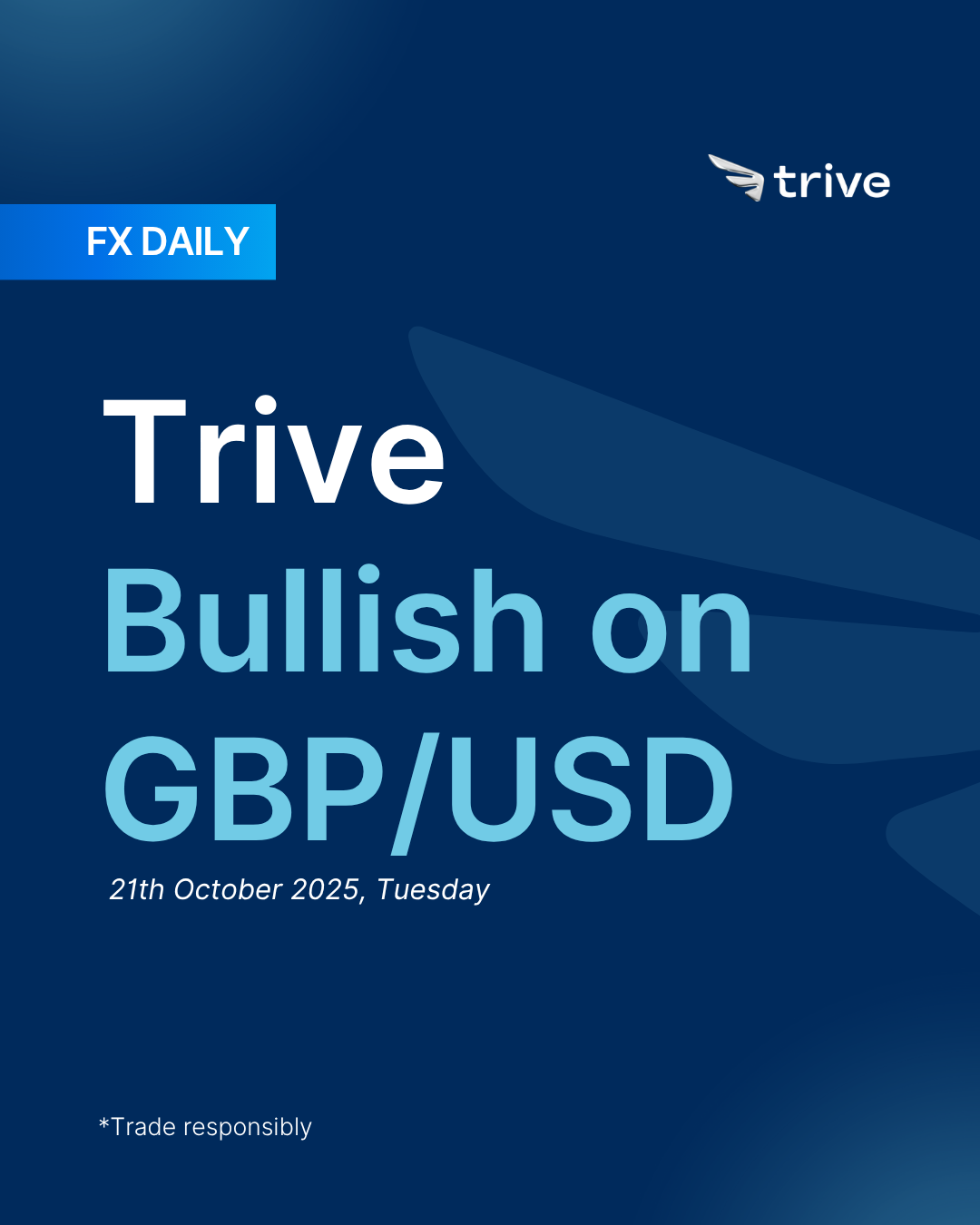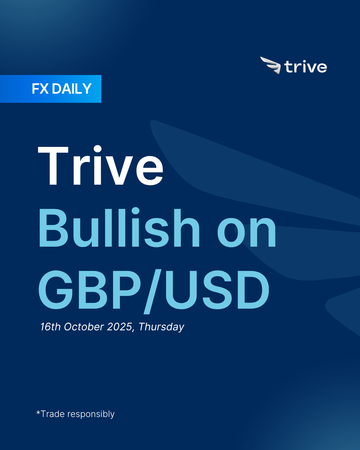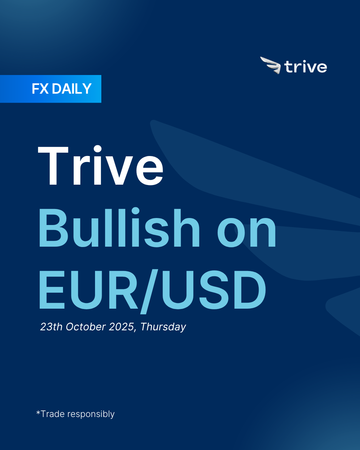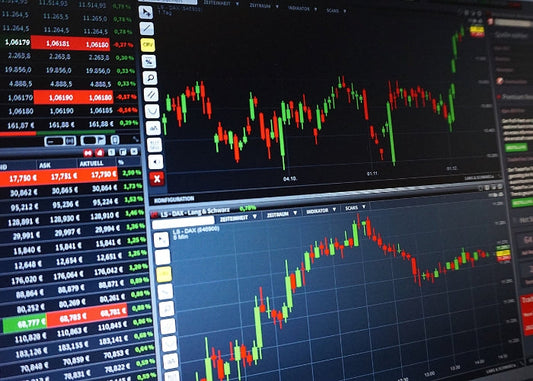FX Daily: Trive Bullish on GBP/USD

The pound weathered a volatile week, initially sliding on softer labour data before rebounding mid-week as USD momentum faded. Although UK fundamentals remain mixed, expectations for limited BoE easing and easing US-China tensions support short-term GBP resilience. With the dollar losing traction and UK inflation likely to stay sticky, we turn bullish on GBP/USD, viewing dips toward 1.33–1.34 as buying opportunities while risk sentiment remains stable.
GBP: Short term strength
The British Pound experienced a volatile week that unfolded in two distinct phases. It initially fell sharply on signs of a cooling domestic economy, then managed to recover mid-week, only to be hit again by the global risk-off sentiment that dominated the latter part of the week. The main domestic event was Tuesday’s labour market report, which showed an unexpected uptick in unemployment and slower wage growth. This weaker data led markets to increase bets on a Bank of England rate cut by year-end, sending GBP/USD to its lowest level since August, near 1.3250.
The pound then staged a steady recovery through the middle of the week, rising to a high near 1.3450 as attention turned to upcoming inflation data and the US Dollar softened broadly. However, the rebound lost momentum as renewed turmoil surrounding US regional banks sparked a global flight to safety, pushing the Dollar higher and forcing Sterling back below 1.3450 by the end of the week.
The labour market report was the key driver early in the week. The ILO unemployment rate unexpectedly rose to 4.8% from 4.7%, while three-month average earnings excluding bonuses slowed to 4.7% year-on-year from 4.8%. These figures painted a picture of a cooling labour market and prompted a dovish repricing of BoE policy expectations. On Thursday, GDP data showed a modest 0.1% month-on-month increase in August, matching expectations, though July’s figure was revised down to -0.1%. The numbers suggested the UK economy is barely growing, which Pantheon Macroeconomics described as “ticking along close to its reduced potential.” Meanwhile, BRC retail sales for September also weakened, indicating growing consumer caution ahead of the November budget.
Comments from Bank of England officials further shaped sentiment. Governor Andrew Bailey noted that the soft labour data supported his view of a weakening job market. More notably, Catherine Mann, one of the MPC’s most hawkish members, acknowledged that economic activity was “modest” and the labour market was “softening,” marking a dovish shift in tone. However, on Friday the tone became more mixed. Chief Economist Huw Pill warned that the August decision to pause rate hikes should be viewed as a “skip rather than a halt,” stressing the risks of persistent inflation. Megan Greene also argued for caution, suggesting that the pace of rate cuts should be slow given that core inflation appears to be stabilizing. This highlighted a clear divide within the Monetary Policy Committee about the future path of interest rates.
Fiscal and political uncertainty also weighed on sentiment. The upcoming November 26th budget remained in focus, with reports suggesting Chancellor Rachel Reeves is aiming to create more fiscal “headroom” through spending cuts and selective tax increases. While she ruled out introducing a formal “wealth tax,” reports indicated that she is considering measures such as higher taxes on pensions and additional contributions from wealthier households to strengthen public finances.
Sterling traded choppily last week, caught between weak domestic data and global sentiment swings. The pound fell early after a soft labour report showed rising unemployment and slower wage growth, which spurred renewed expectations for BoE rate cuts. A mid-week rebound faded as risk-off flows returned, led by renewed concerns about US regional banks. Despite these swings, the pound closed only marginally lower on the week, reflecting both its own fragility and the market’s reluctance to extend shorts while trade tensions weigh more heavily on other cyclical currencies.
Near term, mixed. While the domestic backdrop for sterling remains uninspiring, the currency could outperform higher-beta peers more exposed to global trade frictions. The UK’s fiscal and growth challenges persist, but the pound is less directly tied to the US–China tariff cycle than the AUD, NZD, USD or CAD, and may benefit on a relative basis if risk sentiment weakens further. The main near-term driver will be inflation data, where any moderation in CPI would keep BoE easing expectations alive, while sticky core components could briefly stabilize the currency. Friday’s PMIs will test whether the services sector can hold its ground after last week’s soft labour prints. Taken together, this leaves the near-term outlook mixed: structurally cautious, but with scope for relative resilience if trade war dynamics dominate broader market tone. A firmer CPI or signs of fiscal restraint could tilt the bias modestly bullish, while weaker data or new fiscal slippage would re-introduce downside pressure.
Longer term, weak bearish. The medium-run view remains mildly negative. Sluggish productivity growth, fiscal fragility, and political uncertainty still weigh on sterling’s structural profile, even if short-term positioning looks cleaner. As the BoE moves closer to an eventual easing cycle, relative rate support should fade, leaving the pound reliant on global sentiment and cross-currency flows for direction. Fiscal consolidation efforts might improve credibility but at the expense of growth, keeping rallies capped. Sustained wage strength or stickier inflation could justify revisiting a more neutral stance, but absent these, sterling is likely to underperform currencies with stronger domestic backdrops once global conditions stabilize.
If the broader context flips, say trade tensions ease sharply, risk sentiment improves, or the BoE pushes back firmly against easing expectations the current cautious view could unwind, allowing sterling to firm until either data or policy signals re-align with a softer narrative.
USD: Short at rally
The US Dollar had a volatile week driven by a dramatic mid-week pivot in risk sentiment centered on the US financial system. The DXY started the week on a soft footing, falling below 99.00 as markets reacted to dovish remarks from Fed Chair Powell, who hinted at an early end to the central bank’s balance sheet reduction. This narrative was abruptly disrupted on Thursday by a sharp risk-off move, after reports of bad loans and alleged fraud at regional banks Western Alliance (WAL) and Zions (ZION) reignited fears of a credit crisis. The dollar dropped to a weekly low near 98.30 as traders priced in aggressive Fed rate cuts, which sent haven currencies like the JPY and CHF soaring.
However, sentiment completely reversed on Friday. A wave of strong earnings reports from other regional banks calmed credit fears, while President Trump adopted a softer tone on China, saying high tariffs would “not stand” and confirming a meeting with President Xi. This triggered a powerful risk-on wave that led to a sell-off in Treasuries and gold, allowing the dollar to recover part of its losses and close the week near 98.40.
Regional PMIs delivered a mixed picture, as the government shutdown delayed major data releases. The NY Fed Manufacturing Index on Wednesday surprised with a jump to 10.7 compared to expectations of -1.4, showing solid growth in new orders and employment. On the other hand, the Philly Fed Business Index on Thursday collapsed to -12.8 from an expected 8.5, fueling that day’s risk-off sentiment. The Fed’s Beige Book released on Wednesday described economic activity as “little changed,” noting a muted labor market but rising labor cost pressures, suggesting stagflationary undertones. On Friday, a Bloomberg analysis of state-level data suggested initial jobless claims fell to around 215,000, pointing to a resilient labor market despite being an unofficial figure.
Fed Chair Powell set the dovish tone early in the week by signaling the possible end of quantitative tightening “in the coming months,” which weighed on the dollar as it implied more liquidity ahead. Fed Governor Waller reinforced easing expectations by saying a 25bps cut in October would be “justified,” with further moves depending on incoming data. Dovish comments from Governor Miran and Philly Fed President Paulson added to this narrative. Following the banking scare, markets repriced Fed expectations sharply, fully pricing in two 25bps rate cuts by December, totaling 50bps of easing.
Trade and geopolitical developments also played a major role. The week began with President Trump softening his stance after his weekend threat of 100% tariffs on Chinese goods. Tensions escalated mid-week when China announced countermeasures against US firms but quickly eased after Trump stated that high tariffs were “not sustainable” and confirmed a meeting with President Xi in two weeks, fueling Friday’s rally. Trump’s Thursday phone call with Russian President Putin, described as “very good and productive,” led to plans for high-level staff meetings and helped further reduce geopolitical tension. Earlier in the week, the release of all living Israeli hostages by Hamas was a positive geopolitical event, though it was later overshadowed by US financial news.
Market sentiment was dominated by the regional banking scare on Thursday, when shares of Western Alliance and Zions plunged after disclosures of loan-related fraud. This sparked a flight to quality that sent the KRE regional banking ETF down over 6%, crushed equities, and drove strong gains in gold, Treasuries, and haven currencies. On Friday, the panic reversed as solid earnings from other regional banks like TFC and ALLY eased contagion fears. Combined with Trump’s conciliatory comments on China, risk appetite returned strongly. Gold reflected this shift perfectly, hitting a new record high above $4,370 per ounce during Thursday’s panic before falling more than $180 as risk-on sentiment dominated on Friday.
The dollar endured another turbulent week, whipsawed by shifting narratives around the Fed’s stance and a brief US financial scare. It started on a weak note as dovish remarks from Chair Powell and other officials pushed rate cut expectations higher, but the mid-week panic over regional banks temporarily halted the decline as traders pared back extreme positioning. By Friday, relief in banking stocks and Trump’s conciliatory tone toward China restored risk appetite, leaving the dollar modestly lower overall but far from last week’s lows.
Near term, weak bearish. The main driver remains global risk sentiment, which continues to overshadow domestic fundamentals. While last week’s mid-week volatility briefly interrupted the dollar’s slide, it was JPY and CHF that drew true defensive demand, showing that the USD’s traditional “safety bid” no longer dominates when the shock is US-centered. Domestically, markets look to CPI and PMIs for confirmation of whether growth and inflation momentum can justify the Fed’s dovish tilt. Front-end yields remain soft, and Powell’s reluctance to challenge easing expectations leaves the dollar vulnerable to further repricing. Unless incoming data or Fed communication reassert a firmer policy stance, the mix of gentler US yields and recovering global risk appetite should keep the bias weakly bearish. Only a meaningful upside inflation surprise or renewed stress in credit markets would be enough to shift the tone toward neutral.
Longer term, weak bearish. The broader setup still points to gradual USD underperformance as the Fed transitions toward rate cuts amid cooling growth and fading inflation pressure. The dollar’s carry appeal is diminishing as peers stabilize policy rates, while twin deficits and softer capital inflows continue to weigh on the medium-run picture. Seasonal factors offer some support, but not enough to counterbalance structural headwinds. A sequence of stronger data or a decisive hawkish turn from the Fed could lift the stance toward neutral, yet absent that, the bias remains for a softer dollar as relative rate support erodes and global investors diversify away from the US. If the Fed’s tone turns firmer or inflation re-accelerates meaningfully, this weak bearish view could reverse quickly, prompting renewed USD strength until data or market pricing confirm a sustainable cooling in the cycle.
 GBP/USD 4H
GBP/USD 4H
Disclaimer
This material is provided for informational purposes only and does not constitute financial, investment, or other advice. The opinions expressed in this material are those of the author and do not necessarily reflect the views of Trive International. No opinion contained in this material constitutes a recommendation by Trive International or its author regarding any particular investment, transaction, or investment strategy. This material should not be relied upon in making any investment decision.
The information provided does not consider the individual investment objectives, financial situation, or needs of any specific investor. Investors should seek independent financial advice tailored to their individual circumstances before making any investment decisions. Trive International shall not be liable for any loss, damage, or injury arising directly or indirectly from the use of this information or from any action or decision taken as a result of using this material.
Trive International may or may not have a financial interest in the companies or securities mentioned. The value of investments may fluctuate, and investors may not get back the amount they originally invested. Past performance is not indicative of future results.
For more information about Trive International, please visit http://trive.com/int
Additional Information
Investing involves risk, including the potential loss of principal. Diversification and asset allocation strategies do not ensure a profit or guarantee against loss. The content in this material is subject to change without notice and may become outdated or inaccurate over time. Trive International does not undertake any obligation to update the information in this material.
By accessing this material, you acknowledge and agree to the terms of this disclaimer. If you do not agree with these terms, please refrain from using this information.
No comments
Home
Trive
TriveHub





0 comments